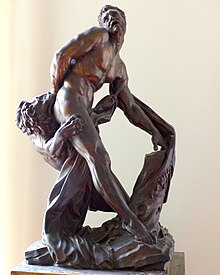
Milo or Milon of Croton (fl. 540 – 511 BC) was a famous ancient Greek athlete from the Greek colony of Croton in Magna Graecia.
He was a six-time Olympic victor; once for boys wrestling in 540 BC at the 60th Olympics, and five-time wrestling champion at the 62nd through 66th Olympiads. Milo kept on competing, even well after what would have been considered a normal Olympic athlete's prime; by the 67th Olympiad, he would have been over 40 years of age. He also attended many of the Pythian Games.
His historicity is attested by many classical authors, among them Aristotle, Pausanias, Cicero, Herodotus, Vitruvius, Epictetus, and the author of the Suda, but there are many legendary stories surrounding him.
Diodorus Siculus wrote in his history that Milo was a follower of Pythagoras and also that he commanded the Crotonian army which defeated the Sybarites in 511 BC, while wearing his Olympic wreaths and dressed like Hercules in a lion's skin and carrying a club.
Hereupon the Sybarites took the field with an army of three hundred thousand men. The Crotonians had but an hundred thousand, which were commanded by Milo the wrestler, who at the first onset put to flight that wing of the army which was opposite to him: for he was of invincible strength, and had courage answerable to his strength, and had been six times victor at the olympic games; when he began his fight, he was crowned with olympic wreaths, wearing (like Hercules) a lion's skin and a club; at last he gained an absolute victory, and thereupon was much admired by his countrymen.
Milo's death became a popular subject in art in late Italian Renaissance sculpture, continuing to around 1900, allowing the sculptor to show his skill in a dramatic anatomical pose. It was a more compact equivalent of the Roman group of Laocoön and His Sons.
Feats of strength

Ancient sources and legends report that he took great pleasure in showing off his strength. He had a number of feats he would perform, such as:
- He would hold his arm out, with fingers outstretched, and challenge people to attempt to bend his little finger.
- He would stand on a greased iron disk and challenge people to push him off of it.
- He would hold a pomegranate in one hand, and challenge others to take it from him. Nobody ever could, and despite him holding the fruit very tightly, it was never damaged.
- He would train in the off years by carrying a newborn calf on his back every day until the Olympics took place. By the time the events were to take place, he was carrying a four-year-old cow on his back. He carried the full-grown cow the length of the stadium, then proceeded to kill, roast, and eat it.
Death

Legend has it that such feats were his eventual undoing. His final test of strength came when he was traveling the countryside and met a villager trying to split a stump with hammer and wedges. Milo excitedly asked the man if he could attempt to split the wood with his strength, not using any tools at all. The villager, honored by Milo's offer, went off to fetch food while Milo worked. Milo immediately tried to pull the stump apart by inserting his fingers in the crack where the villager had driven the wedges. As he pulled the stump open, the wedges fell out, trapping Milo's fingers. Without the wedges there to hold the crack open, when Milo tried, he could not free his fingers from the stump. There he waited for the villager to return with food. Legend then says that Milo met his end when wolves, or a lion, took advantage of his predicament and descended upon him.
Statue

The statue of Milo the son of Diotimus was made by Dameas, also a native of Crotona. Milo won six victories for wrestling at Olympia, one of them among the boys; at Pytho he won six among the men and one among the boys. He came to Olympia to wrestle for the seventh time, but did not succeed in mastering Timasitheus, a fellow-citizen who was also a young man, and who refused, moreover, to come to close quarters with him. It is further stated that Milo carried his own statue into the Altis. His feats with the pomegranate and the quoit are also remembered by tradition. He would grasp a pomegranate so firmly that nobody could wrest it from him by force, and yet he did not damage it by pressure. He would stand upon a greased quoit, and make fools of those who charged him and tried to push him from the quoit. He used to perform also the following exhibition feats. He would tie a cord round his forehead as though it were a ribbon or a crown. Holding his breath and filling with blood the veins on his head, he would break the cord by the strength of these veins. It is said that he would let down by his side his right arm from the shoulder to the elbow, and stretch out straight the arm below the elbow, turning the thumb upwards, while the other fingers lay in a row. In this position, then, the little finger was lowest, but nobody could bend it back by pressure. They say that he was killed by wild beasts. The story has it that he came across in the land of Crotona a tree-trunk that was drying up; wedges were inserted to keep the trunk apart. Milo in his pride thrust his hands into the trunk, the wedges slipped, and Milo was held fast by the trunk until the wolves—a beast that roves in vast packs in the land of Crotona—made him their prey. Such was the fate that overtook Milo.
— Milo in Pausanias' Description of Greece
Bibliography
- Abdo, John (2020). Wolves of Croton: The Untold Story of Milo. Marina del Rey, CA: Ja Publishing, Inc. ISBN 978-1-7356-8471-0.
References
- Diodorus, p. 438
- Diodorus. The Historical Library of Diodorus the Sicilian, 1814 (Original from the New York Public Library).
External links
- Web Gallery of Art Depictions of Milo of Croton by Vittoria, Puget, Falconet, and Suvée
| Ancient Greece | |||||||||||||||||||||||||
|---|---|---|---|---|---|---|---|---|---|---|---|---|---|---|---|---|---|---|---|---|---|---|---|---|---|
| |||||||||||||||||||||||||
| |||||||||||||||||||||||||
| |||||||||||||||||||||||||
| |||||||||||||||||||||||||
| |||||||||||||||||||||||||
| |||||||||||||||||||||||||
